The biggest crocodiles, alligators, caimans – Top 10
Millions of years ago huge reptiles ruled our planet. The ancestors of modern reptiles were enormous. Currently, the largest living reptiles are crocodiles and their cousins – alligators, caimans and gavials. In the past, the ancestors of crocodiles were bigger, this was due to the size of their victims. Because today there is no longer such a large land animals as in the past, crocodiles “somewhat” have shrunk. Although currently living crocodiles are not as great as their relatives from millions of years, the largest among them are still huge and scary. Below is a list of the longest and heaviest crocodiles.
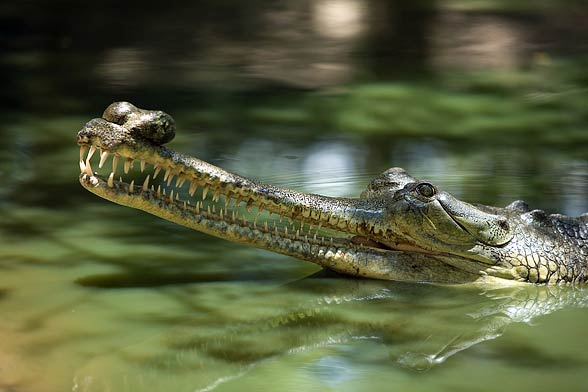
Top 10 longest and heaviest crocodiles
10. Slender-snouted crocodile – 325 kg (717 lb) / 4 m (13 ft)
African slender-snouted crocodile (Mecistops cataphractus)
- Average mass (weight): 125–230 kg (276–507 lb)
- Maximum mass (weight): 325 kg (717 lb)
- Length: 3 to 4 m (9.8 to 13.1 ft)
The African slender-snouted crocodile, also known as the West African slender-snouted crocodile or the long-glanded crocodile, is a species of crocodile that is native to West and Central Africa. It is relatively medium-sized, with a total length ranging from 2.30to 4 meters (7.6 to 13 feet) and a weight ranging from 50 to 230 kilograms (110 to 507 pounds)
The African slender-snouted crocodile has a long, narrow snout and a relatively slender body compared to other crocodile species. Its skin is covered in hard, bony plates called scales, which provide protection from predators and help the animal regulate its body temperature. The color of its skin ranges from greenish-brown to a darker shade of brown.
This species is found in a variety of habitats, including swamps, marshes, and rivers. It is an opportunistic predator, preying on a variety of animals including fish, reptiles, mammals, and birds. The African slender-snouted crocodile is a vocal animal and is known to make a variety of vocalizations, including growls, hisses, and bellows.
The African slender-snouted crocodile is listed as “Endangered” by the International Union for Conservation of Nature (IUCN) due to habitat loss and hunting for its skin. It is also threatened by habitat degradation and pollution. Efforts are being made to conserve this species, including the establishment of protected areas and the implementation of conservation programs.
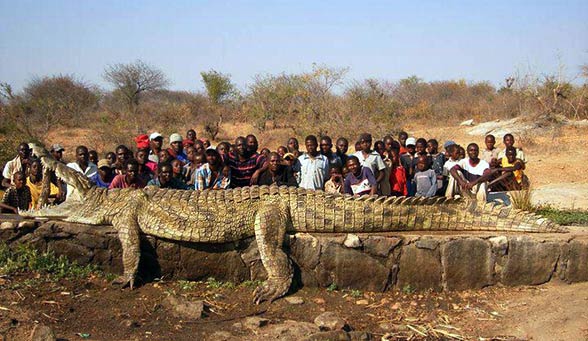
9. False gharial – 500 kg (1,102 lb) / 5 m (16.4 ft)
False gharial (Tomistoma schlegelii)
- Average mass (weight): 150 to 250 kg (331 to 551 lb)
- Maximum mass (weight): 500 kg (1,102 lb)
- Length: 3.6 to 3.9 m (12 to 13 ft) / max. 5 m (16.4 ft)
The false gharial, also known as the Malayan gharial or the Tomistoma crocodile, is a species of crocodile found in Southeast Asia. It is a relatively large species, reaching lengths of up to 5 meters (16 feet) and weighing up to 500 kilograms (1,100 pounds).
The false gharial has a long, narrow snout that is similar in appearance to that of the true gharial, a crocodile species found in India and Nepal. However, the false gharial is not closely related to the true gharial, and is instead more closely related to the mugger crocodile. The false gharial has a wide, flat head and a relatively slender body compared to other crocodile species. Its skin is covered in hard, bony plates called scales, which provide protection from predators and help the animal regulate its body temperature.
This species is found in a variety of freshwater habitats, including swamps, marshes, and rivers. It is an opportunistic predator, preying on a variety of animals including fish, reptiles, mammals, and birds. The false gharial is a vocal animal and is known to make a variety of vocalizations, including growls, hisses, and bellows.
The false gharial is classified as “Critically Endangered” by the International Union for Conservation of Nature (IUCN) due to habitat loss and hunting for its skin. It is also threatened by habitat degradation and pollution. Efforts are being made to conserve this species, including the establishment of protected areas and the implementation of conservation programs.
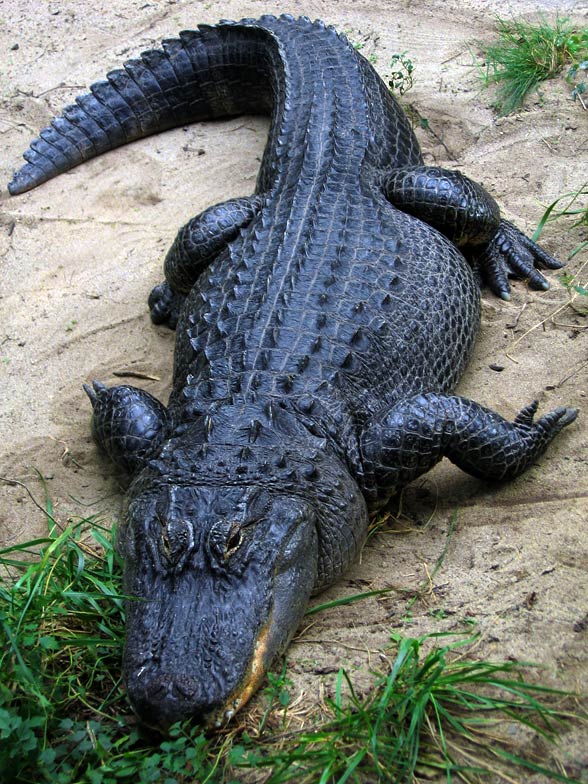
8. Mugger crocodile – 500 kg (1,100 lb) / 5.2 m (17.1 ft)
Mugger crocodile (Crocodylus palustris)
- Average mass (weight): 200 to 250 kg (440 to 550 lb)
- Maximum mass (weight): 500 kg (1,100 lb)
- Length: 4 to 4.5 m (13.1-14.8 ft) / Max. 5.2 m (17.1 ft)
The mugger crocodile, also known as the Indian crocodile or the marsh crocodile, is a species of crocodile native to South and Southeast Asia. It is a large species, typically growing to lengths of up to 5 meters (16.4 feet) and weighing up to 500 kg (1,100 lb).
The mugger crocodile has a wide, flat head and a relatively stocky body compared to other crocodile species. Its skin is covered in hard, bony plates called scales, which provide protection from predators and help the animal regulate its body temperature. The color of its skin ranges from brown to greenish-gray.
This species is found in a variety of freshwater habitats, including swamps, marshes, and rivers. It is an opportunistic predator, preying on a variety of animals including fish, reptiles, mammals, and birds. The mugger crocodile is a vocal animal and is known to make a variety of vocalizations, including growls, hisses, and bellows.
The mugger crocodile is classified as “Vulnerable” by the International Union for Conservation of Nature (IUCN) due to habitat loss and hunting for its skin. It is also threatened by habitat degradation and pollution. Efforts are being made to conserve this species, including the establishment of protected areas and the implementation of conservation programs.
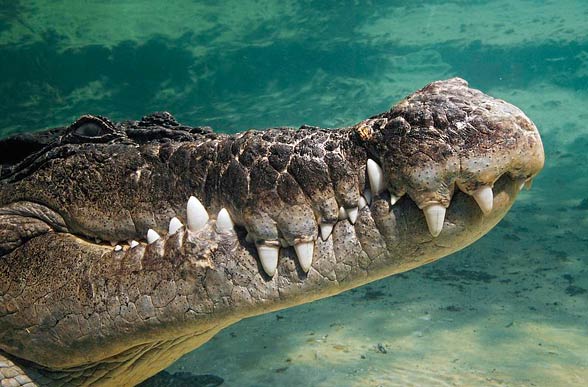
7. American alligator – 1,000 kg (2,200 lb) / 6 m (20 ft)
American alligator (Alligator mississippiensis)
- Average mass (weight): 240 kg (530 lb)
- Maximum mass (weight): 1,000 kg (2,200 lb)
- Length: 3.4 to 4.6 m (11 to 15 ft) / Max. 6 m (20 ft)
The American alligator, also known as the common alligator or the Mississippi alligator, is a species of crocodilian native to the southeastern United States. It is a large species, typically growing to lengths of up to 4.5 meters (15 feet) and weighing up to 450 kilograms (1,000 pounds). The average mass of an American alligator is around 240 kilograms (530 pounds), and that it can reach a maximum mass of up to 1,000 kilograms (2,200 pounds). The typical length of the American alligator ranges from 3.4 to 4.6 meters (11 to 15 feet), although some individuals can reach lengths of up to 6 meters (20 feet)
The American alligator has a broad, rounded snout and a relatively stocky body compared to other crocodile species. Its skin is covered in hard, bony plates called scales, which provide protection from predators and help the animal regulate its body temperature. The color of its skin ranges from dark green to black.
This species is found in a variety of freshwater habitats, including swamps, marshes, and rivers. It is an opportunistic predator, preying on a variety of animals including fish, reptiles, mammals, and birds. The American alligator is a vocal animal and is known to make a variety of vocalizations, including growls, hisses, and bellows.
The American alligator was once hunted to near extinction for its skin, but it has since made a comeback due to conservation efforts. It is now classified as “Least Concern” by the International Union for Conservation of Nature (IUCN), but it is still protected by law in the United States.
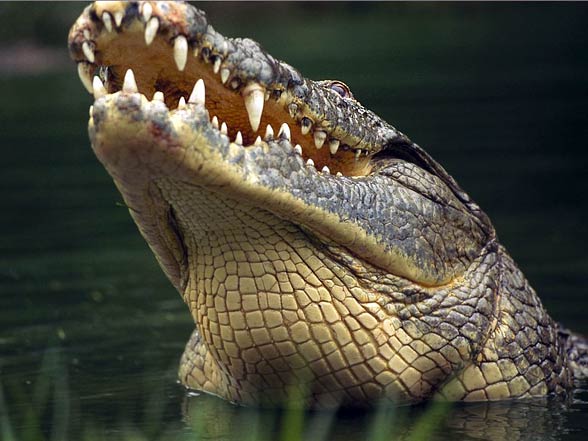
6. Gharial – 977 kg (2,154 lb) / 6.25 m (20.5 ft)
Gharial (Gavialis gangeticus)
- Average mass (weight): 160 to 250 kg (352 to 551 lb)
- Maximum mass (weight): 977 kg (2,154 lb)
- Length: 3 to 5 m (9.8 to 16.4 ft) / Max 6.25 m (20.5 ft)
The gharial, also known as the gavial or the fish-eating crocodile, is a species of crocodilian native to India and Nepal. It is a relatively large species, typically growing to lengths of up to 6.25 m (20.5 ft) and weighing up to 1,000 kilograms (2,200 pounds).
The gharial has a long, narrow snout that is adapted for catching and eating fish. It has a relatively slender body compared to other crocodile species, and its skin is covered in hard, bony plates called scales, which provide protection from predators and help the animal regulate its body temperature. The color of its skin ranges from olive green to dark brown.
This species is found in a variety of freshwater habitats, including swamps, marshes, and rivers. It is an opportunistic predator, preying on a variety of animals including fish, reptiles, mammals, and birds. The gharial is a vocal animal and is known to make a variety of vocalizations, including growls, hisses, and bellows.
The gharial is classified as “Critically Endangered” by the International Union for Conservation of Nature (IUCN) due to habitat loss and hunting for its skin. It is also threatened by habitat degradation and pollution. Efforts are being made to conserve this species, including the establishment of protected areas and the implementation of conservation programs.
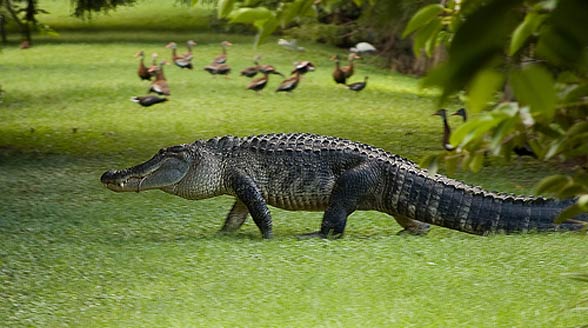
5. American crocodile – 1,000 kg (2,200 lb) / 6.6 m (22 ft)
American crocodile (Crocodylus acutus)
- Average mass (weight): 382 kg (842 lb
- Maximum mass (weight): 1,000 kg (2,200 lb)
- Length: 4.3 m (14 ft) / Max. 6.6 m (22 ft)
The American crocodile is a species of crocodilian native to the tropical regions of the Americas, including Central and South America, as well as parts of the Caribbean. It is a large species, typically growing to lengths of up to 5 meters (16 feet) and weighing up to 600 kilograms (1,320 pounds). The average mass of an American crocodile is around 382 kilograms (842 pounds), and that it can reach a maximum mass of up to 1,000 kilograms (2,200 pounds). The American crocodile ranges from 4.3 to 6.6 meters (14 to 22 feet).
The American crocodile has a long, narrow snout and a relatively slender body compared to other crocodile species. Its skin is covered in hard, bony plates called scales, which provide protection from predators and help the animal regulate its body temperature. The color of its skin ranges from brown to greenish-gray.
This species is found in a variety of freshwater and saltwater habitats, including swamps, marshes, and rivers. It is an opportunistic predator, preying on a variety of animals including fish, reptiles, mammals, and birds. The American crocodile is a vocal animal and is known to make a variety of vocalizations, including growls, hisses, and bellows.
The American crocodile is classified as “Near Threatened” by the International Union for Conservation of Nature (IUCN) due to habitat loss and hunting for its skin. It is also threatened by habitat degradation and pollution. Efforts are being made to conserve this species, including the establishment of protected areas and the implementation of conservation programs.
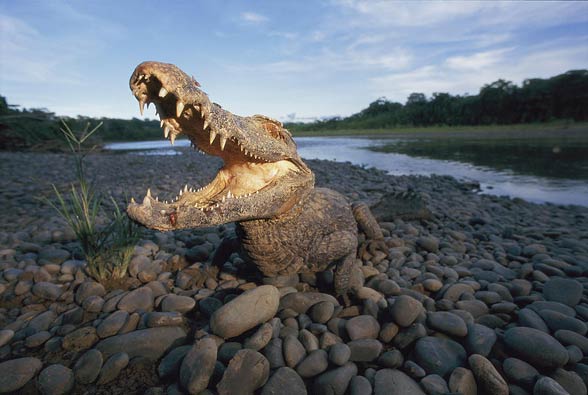
4. Black caiman – 1,100 kg (2,400 lb) / over 6 m (20 ft)
Black caiman (Melanosuchus niger)
- Average mass (weight): 350 kg (770 lb)
- Maximum mass (weight): 1,100 kg (2,425 lb)
- Length: 4 to 5 m (13–16 ft) / Max. – over 6 m (20 ft)
The black caiman is a species of crocodilian native to the tropical regions of South America, including the Amazon and Orinoco basins. It is the largest reptile in the Americas, reaching lengths of up to 6 meters (20 feet) and weighing up to 1,100 kg (2,425 lb).
The black caiman has a long, narrow snout and a relatively stocky body compared to other crocodile species. Its skin is covered in hard, bony plates called scales, which provide protection from predators and help the animal regulate its body temperature. As its name suggests, the black caiman has dark-colored skin that ranges from black to dark brown.
This species is found in a variety of freshwater habitats, including swamps, marshes, and rivers. It is an opportunistic predator, preying on a variety of animals including fish, reptiles, mammals, and birds. The black caiman is a vocal animal and is known to make a variety of vocalizations, including growls, hisses, and bellows.
The black caiman is classified as “Endangered” by the International Union for Conservation of Nature (IUCN) due to habitat loss and hunting for its skin. It is also threatened by habitat degradation and pollution. Efforts are being made to conserve this species, including the establishment of protected areas and the implementation of conservation programs.
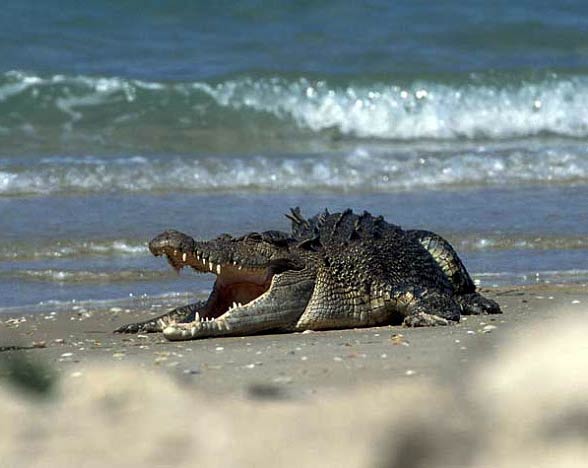
3. Orinoco crocodile – 1,100 kg (2,400 lb) / 6.6 m (22 ft)
Orinoco crocodile (Crocodylus intermedius)
- Average mass (weight): 380 kg (840 lb)
- Maximum mass (weight): 1,100 kg (2,400 lb)
- Length: 4.1 m (13.5 ft) / Max. 6.6 m (22 ft)
The Orinoco crocodile is a species of crocodilian native to the Orinoco River basin in South America. It is a large species, typically growing to lengths of up to 5 meters (16 feet) and weighing up to 1,100 kilograms (2,400 pounds).
The Orinoco crocodile has a long, narrow snout and a relatively slender body compared to other crocodile species. Its skin is covered in hard, bony plates called scales, which provide protection from predators and help the animal regulate its body temperature. The color of its skin ranges from olive green to dark brown.
This species is found in a variety of freshwater habitats, including swamps, marshes, and rivers. It is an opportunistic predator, preying on a variety of animals including fish, reptiles, mammals, and birds. The Orinoco crocodile is a vocal animal and is known to make a variety of vocalizations, including growls, hisses, and bellows.
The Orinoco crocodile is classified as “Critically Endangered” by the International Union for Conservation of Nature (IUCN) due to habitat loss and hunting for its skin. It is also threatened by habitat degradation and pollution. Efforts are being made to conserve this species, including the establishment of protected areas and the implementation of conservation programs.
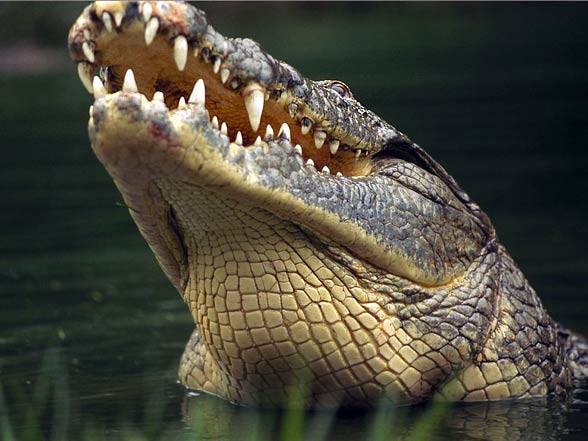
2. Nile crocodile – 1,090 kg (2400 lb) / 6.45 m (21.1 ft)
Nile crocodile (Crocodylus niloticus)
- Average mass (weight): 410 kg (904 lb)
- Maximum mass (weight): 1,090 kg (2400 lb)
- Length: 4.2 m (13.8 ft) / Max. 6.45 m (21.1 ft)
The Nile crocodile is a species of crocodilian native to Africa, including countries such as Sudan, Ethiopia, Kenya, and Tanzania. It is a large species, typically growing to lengths of up to 6 meters (20 feet) and weighing up to 1,100 kilograms (2,400 pounds).
The Nile crocodile has a broad, rounded snout and a relatively stocky body compared to other crocodile species. Its skin is covered in hard, bony plates called scales, which provide protection from predators and help the animal regulate its body temperature. The color of its skin ranges from greenish-brown to a darker shade of brown.
This species is found in a variety of freshwater habitats, including swamps, marshes, and rivers. It is an opportunistic predator, preying on a variety of animals including fish, reptiles, mammals, and birds. The Nile crocodile is a vocal animal and is known to make a variety of vocalizations, including growls, hisses, and bellows.
The Nile crocodile is classified as “Least Concern” by the International Union for Conservation of Nature (IUCN) due to its wide distribution and relatively stable population. However, it is still threatened by habitat loss and hunting for its skin, and efforts are being made to conserve this species, including the establishment of protected areas and the implementation of conservation programs.
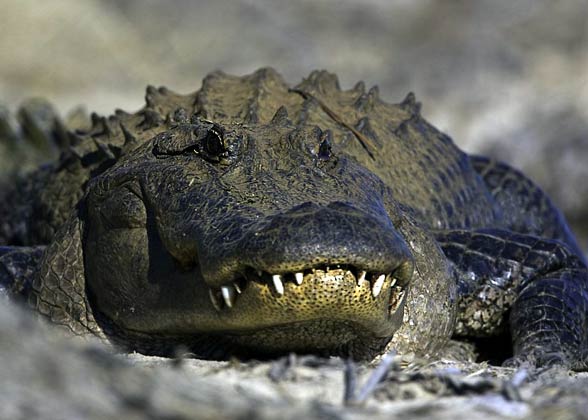
The largest (longest and heaviest) crocodile:
1. Saltwater crocodile – 2,000 kg (4,400 lb) / 7.1 m (23.3 ft)
Saltwater crocodile (Crocodylus porosus)
- Average mass (weight): 450 kg (990 lb)
- Maximum mass (weight): 2,000 kg (4,400 lb)
- Length: 4.5 m (14.8 ft) / Max. 7.1 m (23.3 ft)
The saltwater crocodile, also known as the estuarine crocodile or the Indo-Pacific crocodile, is a species of crocodilian native to the tropical regions of South and Southeast Asia, as well as northern Australia and the surrounding islands. It is the largest living reptile in the world, reaching lengths of up to 7 meters (23 feet) and weighing up to 2,000 kilograms (4,400 pounds).
The saltwater crocodile has a long, narrow snout and a relatively stocky body compared to other crocodile species. Its skin is covered in hard, bony plates called scales, which provide protection from predators and help the animal regulate its body temperature. The color of its skin ranges from brown to greenish-gray.
This species is found in a variety of freshwater and saltwater habitats, including swamps, marshes, and rivers. It is an opportunistic predator, preying on a variety of animals including fish, reptiles, mammals, and birds. The saltwater crocodile is a vocal animal and is known to make a variety of vocalizations, including growls, hisses, and bellows.
The saltwater crocodile is classified as “Least Concern” by the International Union for Conservation of Nature (IUCN) due to its wide distribution and relatively stable population. However, it is still threatened by habitat loss and hunting for its skin, and efforts are being made to conserve this species, including the establishment of protected areas and the implementation of conservation programs.






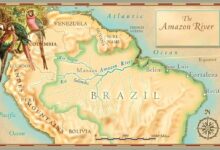

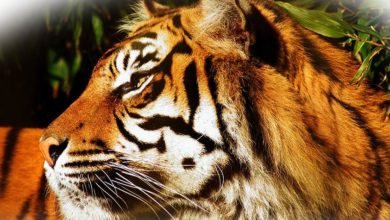


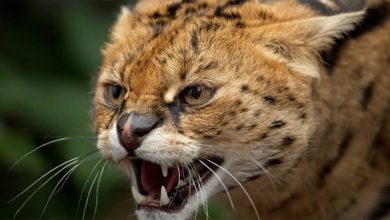

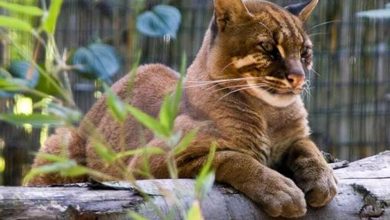






Gostaria de saber por gentileza, que fontes foram usadas para apresentar um peso de 1.100 kg para um Melanosuchus niger. Nunca ouvi ou li isso.
You can find such information about maximum weight of Melanosuchus niger in Wikipedia for instance.
sarcosuchus and deinosuchus
is the biggest
The reason why the Saltie is both the largest, has strongest bite and considered most aggressive while the Nile is the most dangerous in terms of deaths caused is population density of people around them. Think about it.